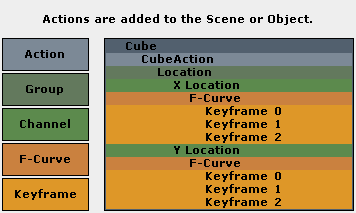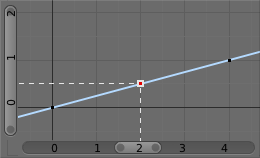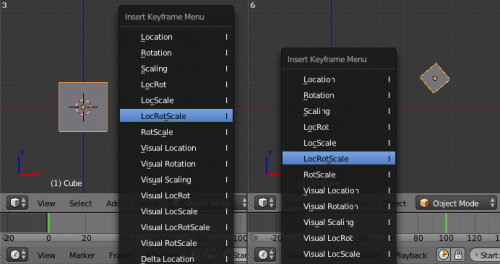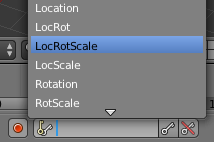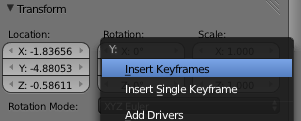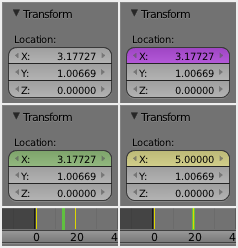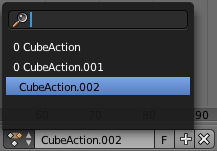Doc:2.6/Manual/Animation/Basics/Actions
< Doc:2.6 | Manual | Animation | Basics(Doc:2.6/Manual/Animation/Keyframesから転送)
目次
[非表示]Actions
Actions
- When animating objects and properties in blender, Actions record and contain the data.
- So when you animate an object by changing its location with keyframes, the animation is saved to the Action.
- Each property has a channel which it is recorded to, for example, Cube.location.x is recorded to Channel X Location.
- Actions
- Record and contain animation data.
- Groups
- Are groups of channels.
- Channels
- Record properties.
- F-Curves
- Are used to interpolate the difference between the keyframes.
- Keyframes
- Are used to set the values of properties.
F-Curve Interpolation
The keyframes are set values by the user.
The F-Curve is used to interpolate the difference between the keyframes.
The F-Curve has different types of interpolation and also F-Curve Modifiers.
Most the settings for the F-Curve are found in the Graph Editor.
Basic Animation
- These are some common ways to animate objects.
- These methods can be used on different objects, like armature bones in pose mode.
Insert Keyframes
- This example shows you how to animate a cubes location, rotation, and scale.
- First, in the Timeline, or other animation editors, set the frame to 1.
- With the Cube selected in Object Mode, press I in the 3D View.
- From the Insert Keyframe Menu select LocRotScale.
- This will record the location, rotation, and scale, for the Cube on frame 1.
- Set the frame to 100.
- Use Grab/Move G, Rotate R, Scale S, to transform the cube.
- Press I in the 3D View. From the Insert Keyframe Menu select LocRotScale.
- To test the animation, press AltA to play.
Auto Keyframe
- Auto Keyframe is the red record button in the Timeline header. Auto Keyframe adds keyframes automatically to the set frame if the value for transform type properties changes.
- See Timeline V Keyframe Control for more info.
Keying Sets
- Keying Sets are a set of keyframe channels. They are used to record multiple properties at the same time. There are some built in keying sets, 'LocRotScale', and also custom keying sets can be made.
- To use the keying set, first select a keying set from the Timeline header, or the Keying Sets Panel.
- Now when you press I in the 3D view, blender will add keyframes for all the properties in the active keying set.
- See Keying Sets for more info.
Properties
- Keyframes can be used to animate lots of different properties in blender.
- To add keyframes to a property in the UI, RMB
 the property, then select Insert Single Keyframe, or Insert Keyframes.
the property, then select Insert Single Keyframe, or Insert Keyframes. - Insert Keyframes I will add a keyframes for the set of properties.
- Properties have different colors and menu items for different states.
- Gray - Property is not animated with Keyframes or Drivers.
- Insert Keyframes I.
- Insert Single Keyframe.
- Add Drivers.
- Add Single Driver.
- Paste Driver.
- Purple - Property value is controlled with a Driver.
- Delete Drivers.
- Delete Single Driver.
- Copy Driver.
- Paste Driver.
- Green - Property has Channel with Keyframes.
- Insert Keyframes I.
- Insert Single Keyframe.
- Clear Keyframes Alt⇧ ShiftI
- Clear Single Keyframes.
- Yellow - Property has Keyframes on the current Frame.
- Replace Keyframes I.
- Replace Single Keyframe.
- Delete Keyframes AltI.
- Delete Single Keyframe.
- Clear Keyframes Alt⇧ ShiftI
- Clear Single Keyframes.
- Each property also has some Keying Set options.
- Add All to Keying Set K.
- Add Single to Keying Set.
- Remove from Keying Set.
Editing
- 3D View.
- Insert Keyframes on current frame I
- Delete Keyframes on current frame AltI
Working with Actions
- When you first animate an object by adding keyframes, blender creates an Action to record the data.
- Actions can be managed with the Action Browser in the DopeSheet Action Editor header, or the properties region of the NLA Editor.
- If you are making multiple actions for the same object, press the F button for each action, this will give the actions a Fake User and will make blender save the unlinked actions.
- Objects can only use one Action at a time for editing, the NLA Editor is used to blend mutiple actions together.
